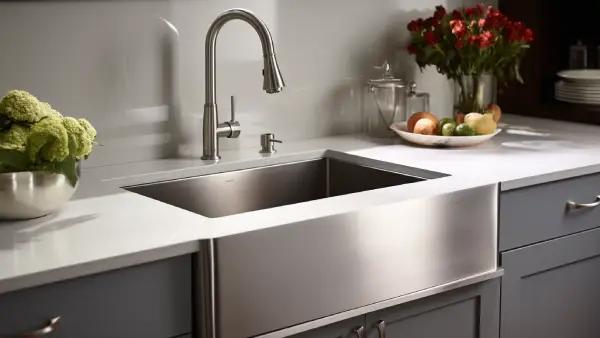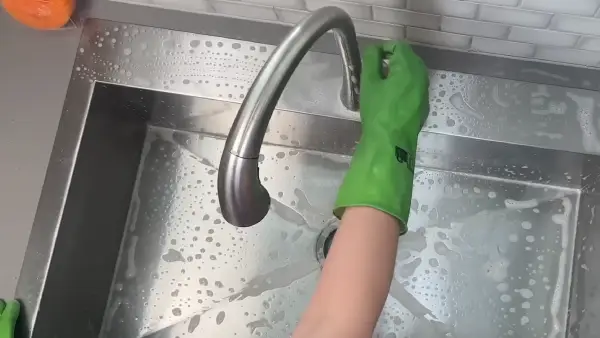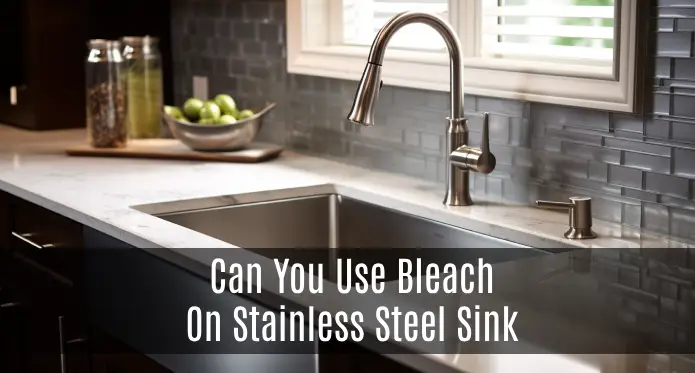Last Updated on November 14, 2023
Maintaining a stainless steel kitchen sink’s cleanliness is essential for hygiene and lifespan. You may want to clean your stainless steel sink with bleach, which is also used for other cleaning purposes. However, there are some cleaning agents that you should avoid using on stainless steel, including bleach.
If you want to maintain the integrity of your stainless steel sink, try to avoid using bleach on it. Bleach, specifically chlorine bleach, shouldn’t be used on stainless steel sinks since it can damage the protective layer.
When bleach comes into contact with the sink, it can corrode the surface and cause discoloration and pitting. Also, bleach can discolor and damage the sink’s components causing discoloration and damage to the sink’s components.
Throughout this article, we will explore why using bleach on your sink can lead to damage and alternative ways to keep your stainless steel sparkling and pristine. So keep reading for more information.
Why Shouldn’t You Clean Stainless Steel Kitchen Sinks With Bleach?

Using bleach to wash your stainless steel sink may seem quick and effective, but it can cause more harm than good. These are 4 reasons:
- Damaging the protective layer
- Toxic fumes
- Staining the surface
- Rust and corrosion on other components
1. Damaging the Protective Layer
The protective layer of stainless steel is essential in preventing corrosion and maintaining its durability.
However, prolonged or frequent use of bleach can weaken the protective layer of chromium oxide, making your sink more susceptible to damage. This can result in rust and pitting, compromising the integrity and appearance of your sink.
So be cautious when using bleach on stainless steel surfaces and ensure thorough rinsing to avoid potential harm.
2. Toxic Fumes
When bleach makes contact with the protective chromium oxide layer on stainless steel, it can create chlorine gas and other harmful fumes. These fumes can cause respiratory issues and eye irritation, especially when used in a confined space without proper ventilation.
3. Staining the Surface
The stainless steel used in sinks is typically resistant to rust and corrosion but is still susceptible to damage from certain chemicals. Bleach contains harsh chemicals, such as sodium hypochlorite, which can react with stainless steel, causing stains and discoloration.
These stains can be difficult to remove and require specialized cleaning products or techniques.
4. Rust and Corrosion on Other Components
If your stainless steel sink includes other components made of non-stainless steel materials, you should avoid using bleach because it can cause rust and corrosion.
When bleach interacts with non-stainless steel components such as faucets or plumbing fixtures, it can cause a chemical reaction, leading to rust and corrosion. This can weaken the structural integrity of the affected parts and, over time, result in their deterioration.
What Can You Use to Clean Your Stainless Steel Kitchen Sink?
To clean your stainless steel sink in your kitchen, you have several options.
1. Dish Soap and Warm Water
Mixing dish soap and warm water is an efficient method to clean your kitchen sink. To begin, combine a few sprinkles of dish soap with warm water in a bucket or sink. The warm water helps break down grease or grime on the sink’s surface.
Next, take a sponge or a soft cloth and dip it into the soapy water mixture. Use this to scrub the steel sink’s surface, paying extra care to any areas that may be particularly dirty or stained. Once thoroughly scrubbing the sink, rinse it with clean water to remove any soap residue.
2. Vinegar and Baking Soda
Sprinkle baking soda onto your stainless steel kitchen sink and pour white vinegar over it to create a fizzy cleaning solution. This combination of ingredients creates a chemical reaction that helps to remove stains and grime from the surface of your sink.
The baking soda acts as a gentle abrasive, while the vinegar’s acidic properties help to dissolve and break down dirt and grease. You can effectively remove stubborn stains or buildup by scrubbing the mixture with a soft brush or sponge.
After scrubbing, wash the sink extensively with water and wipe it dry to prevent any water spots or residue. This method is a safe and effective way to clean your stainless steel sink without using an abrasive pad and harsh chemicals.
3. Commercial Stainless Steel Cleaner
You can use a commercial stainless steel cleaner or a mixture of water and dish soap to effectively clean your stainless steel sink. These cleaners are specifically formulated to remove dirt, grime, and stains from stainless steel surfaces.
They contain ingredients that help to break down grease and remove tough stains without scratching the surface.
When using a commercial stainless steel cleaner, following the manufacturer’s instructions for usage is important. This may include applying the cleaner to a cloth or sponge and then wiping the sink in a circular motion. After cleaning, rinse the sink carefully with water to wash away any residue.
4. Lemon and Salt
Rubbing the lemon and salt mixture on your stainless steel sink can also help remove and leave stains sparkling. Combining lemon’s acidic properties and salt’s abrasive nature creates a powerful cleaning agent.
Lemon juice contains citric acid, which can break down stubborn stains and grease. When mixed with salt, it forms a paste that can be easily applied and scrubbed onto the sink’s surface. The coarse texture of salt acts as a gentle abrasive, helping to lift away dirt and grime.
Now, gently scrub with a soft bristle brush and thoroughly rinse the sink with water to remove any residue. This natural cleaning method is a cost-effective and eco-friendly alternative to commercial stainless steel cleaners.
5. Club Soda
Sometimes, pouring club soda onto the stainless steel kitchen sink can help remove stains and keep it looking shiny. Club soda’s carbonation and mild acidity make it an effective cleaner for stainless steel surfaces.
When you pour club soda onto the sink, the carbonation helps break down and lift stains, while the mild acidity helps dissolve grease or grime.
To clean your sink with club soda, simply pour it onto the surface and scrub gently with soft cloths or sponges. Rinse the sink with water and dry it thoroughly to prevent water spots.
What is the best thing to clean a stainless steel sink with?

Using white vinegar is the best way to clean a stainless steel sink. Fill a spray bottle with equal parts water and white vinegar, and for a more pleasant scent, add a few splashes of lemon juice. After shaking the bottle well, spray the stainless steel surfaces you want to clean.
Take a soft cloth and wipe your sink, making sure to follow the direction of the grain. White vinegar effectively removes water marks and soap scum from stainless steel sinks.
Its acidic properties help break down the stains and leave your sink looking clean and shiny. Also, white vinegar is a natural and non-toxic cleaner, making it a safe choice for your kitchen.
Conclusion
After considering the potential damage that bleach can cause to stainless steel sinks, bleach is an inadvisable solution. It can break down the protective layer, produce toxic fumes, stain the surface, and cause rust and corrosion on its components.
The good news is that there are plenty of safe and effective alternatives, such as dish soap, vinegar and baking soda, commercial stainless steel cleaners, lemon and salt, and club soda.
If you follow those methods, you can maintain the shine and cleanliness of your stainless steel sink without causing any damage. Always read the manufacturer’s instructions before using any cleaning product on your stainless steel sink.

